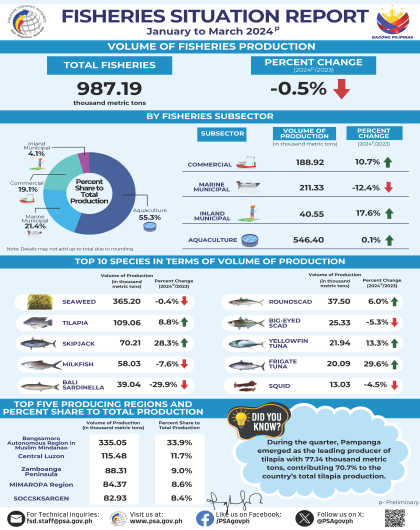Fisheries Situation Report, January to March 2024

In 2021, total fisheries production was recorded at 4,250.79 thousand metric tons from 4,400.37 thousand metric tons output a year ago, representing an annual downtrend of -3.4 percent. This was brought about by the decreases in production from commercial and marine municipal fisheries, and aquaculture. Only inland fisheries registered an improvement in production during the period. (Figure 1 and Table 1)

The total volume of production for commercial fisheries during the year was estimated at 871.24 thousand metric tons. The production was -10.7 less than the output in the previous year at 975.21 thousand metric tons. The subsector’s share to total fisheries was 20.5 percent. (Figure 2 and Table 1)

The marine municipal fisheries subsector produced a total of 927.70 thousand metric tons during the year. It posted a decline of -2.6 percent from the 2020 production level of 952.19 thousand metric tons. Of the total fisheries production, the subsector comprised 21.8 percent. (Figure 3 and Table 1)

Inland fisheries production was registered at 205.54 thousand metric tons during the year. The volume was 37.0 percent higher than the 2020 estimate of 150.07 thousand metric tons. About 4.8 percent of the total fisheries output came from inland fisheries. (Figure 4 and Table 1)

Total harvests from aquaculture farms reached 2,246.32 thousand metric tons in 2021, from 2,322.91 thousand metric tons in the previous year, indicating an annual decline of -3.3 percent. Aquaculture subsector constituted the biggest share of 52.8 percent to total fisheries production. (Figure 5 and Table 1)
Of the 20 major species, double digit production cuts were mainly noted in yellowfin tuna (tambakol/bariles, -22.0%), fimbriated sardines (tunsoy, -15.0%), frigate tuna (tulingan, -14.5%), bigeye tuna (tambakol/bariles, -11.6%), roundscad (galunggong, -10.8%) and threadfin bream (bisugo, -10.7%). (Table 2)
On the other hand, significant increments were reported in mudcarb (alimango, 19.4%) and tilapia (11.8%). (Table 2)


DENNIS S. MAPA, Ph.D.
Undersecretary
National Statistician and Civil Registrar General

